Theodore Edward Cantor (1809–1860) was a Danish physician, zoologist and botanist.

The Indian softshell turtle, or Ganges softshell turtle is a species of softshell turtle found in South Asia in rivers such as the Ganges, Indus and Mahanadi. This vulnerable turtle reaches a carapace length of up to 94 cm (37 in). It feeds mostly on fish, amphibians, carrion and other animal matter, but also takes aquatic plants. This turtle is listed in part II of Schedule I of the Wild Life (Protection) Act, 1972 and possession of this species is an offence.

The red-rimmed melania, scientific name Melanoides tuberculata, is a species of freshwater snail with an operculum, a parthenogenetic, aquatic gastropod mollusk in the family Thiaridae.

The crab-eating mongoose is a mongoose species ranging from the northeastern Indian subcontinent and Southeast Asia to southern China and Taiwan. It is listed as Least Concern on the IUCN Red List.

The Zoological Survey of India (ZSI), founded on 1 July 1916 by Government of India Ministry of Environment, Forest and Climate Change, as premier Indian organisation in zoological research and studies to promote the survey, exploration and research of the fauna in the country.
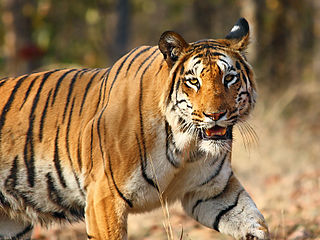
India is home to a large variety of wildlife. It is a biodiversity hotspot with its various ecosystems ranging from the Himalayas in the north to the evergreen rain forests in the south, the sands of the west to the marshy mangroves of the east. India lies within the Indomalayan realm and is the home to about 7.6% of mammal, 14.7% of amphibian, 6% of bird, 6.2% of reptilian, and 6.0% of flowering plant species. India's forest lands nurture about 500 species of mammals and 2000+ bird species.
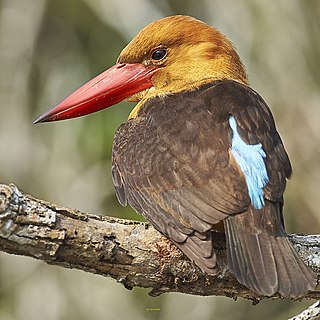
The brown-winged kingfisher is a species of bird in the subfamily Halcyoninae.

Pomatiopsidae is a family of small, mainly freshwater snails, that have gills and an operculum, aquatic gastropod mollusks in the superfamily Truncatelloidea.

William Theobald was a malacologist and naturalist on the staff of the Geological Survey of India serving in Burma, then a part of British India.
William Henry Benson was a civil servant in British India and an amateur malacologist. He made large collections of molluscs and described numerous species from the U.K., India and South Africa.

Anentome helena, common name assassin snail or bumblebee snail, is a species of freshwater snail with an operculum, an aquatic gastropod in the family Nassariidae, most of which are marine.

Freshwater snails are gastropod mollusks which live in fresh water. There are many different families. They are found throughout the world in various habitats, ranging from ephemeral pools to the largest lakes, and from small seeps and springs to major rivers. The great majority of freshwater gastropods have a shell, with very few exceptions. Some groups of snails that live in freshwater respire using gills, whereas other groups need to reach the surface to breathe air. In addition, some are amphibious and have both gills and a lung. Most feed on algae, but many are detritivores and some are filter feeders.

Indoplanorbis is a genus of air-breathing freshwater snail. Its only member species is Indoplanorbis exustus, an aquatic pulmonate gastropod mollusk in the family Planorbidae, the ram's horn snails. The species is widely distributed across the tropics. It serves as an important intermediate host for several trematode parasites. The invasive nature and ecological tolerance of Indoplanorbis exustus add to its importance in veterinary and medical science.
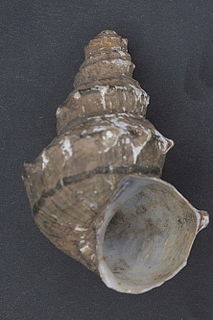
Margarya melanioides is a species of large operculate freshwater snail, an aquatic gastropod mollusk in the family Viviparidae, the river snails.

Megalochelys is an extinct genus of cryptodiran tortoises that lived from the Miocene to Pleistocene. They are noted for their giant size, which is among the largest of any known testudine, with a maximum carapace length over 2 m (6.5 ft) in M. atlas. During the dry glacial periods it ranged from western India and Pakistan to as far east as Sulawesi and Timor in Indonesia, though the island specimens likely represent distinct species.
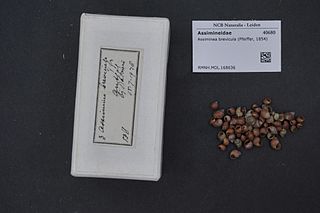
Optediceros breviculum, common name the red mangrove snail, is a species of minute operculate snail, a freshwater or marine gastropod mollusk or micromollusk in the family Assimineidae.
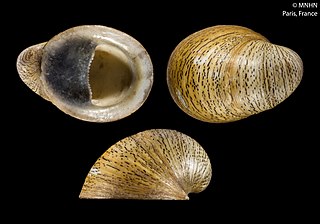
Neripteron cornucopia is a species of freshwater snail, an aquatic gastropod mollusk in the family Neritidae, the nerites.

Neripteron violaceum is a species of brackish water snail, an aquatic gastropod mollusk in the family Neritidae, the nerites.

Gyraulus convexiusculus is a species of freshwater snail, an aquatic pulmonate gastropod mollusk in the family Planorbidae, the ram's horn snails.

Placobdelloides siamensis is a species of blood-feeding jawless leech in the family Glossiphoniidae. It is commonly known as the Siam shield leech and is a prevalent ectoparasite on Malayemys turtles but has a range of Geoemydidae hosts. In high numbers it can cause severe anaemia and malnutrition which can lead to the death of its host.



















